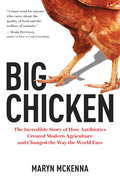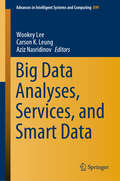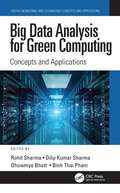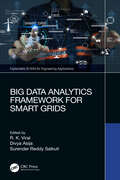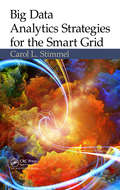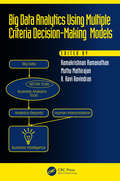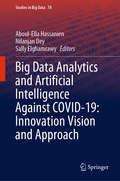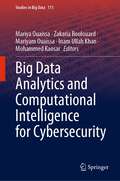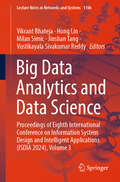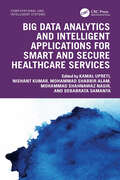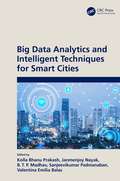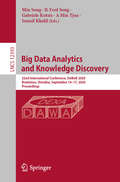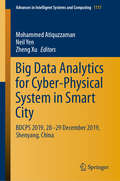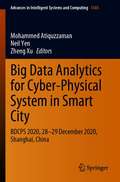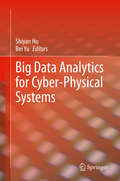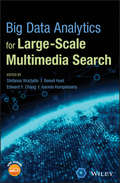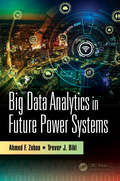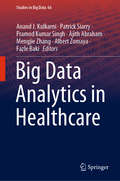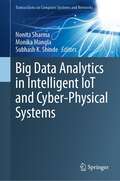- Table View
- List View
Big Chicken: The Incredible Story of How Antibiotics Created Modern Agriculture and Changed the Way the World Eats
by Maryn MckennaIn this eye-opening exposé, acclaimed health journalist and National Geographic contributor Maryn McKenna documents how antibiotics transformed chicken from local delicacy to industrial commodity—and human health threat—uncovering the ways we can make America's favorite meat safer again. What you eat matters—for your health, for the environment, and for future generations. In this riveting investigative narrative, McKenna dives deep into the world of modern agriculture by way of chicken: from the farm where it's raised directly to your dinner table. Consumed more than any other meat in the United States, chicken is emblematic of today's mass food-processing practices and their profound influence on our lives and health. Tracing its meteoric rise from scarce treat to ubiquitous global commodity, McKenna reveals the astounding role of antibiotics in industrial farming, documenting how and why "wonder drugs" revolutionized the way the world eats—and not necessarily for the better. Rich with scientific, historical, and cultural insights, this spellbinding cautionary tale shines a light on one of America's favorite foods—and shows us the way to safer, healthier eating for ourselves and our children.
Big Chicken: The Incredible Story of How Antibiotics Created Modern Agriculture and Changed the Way the World Eats
by Maryn MckennaIn this eye-opening exposé, acclaimed health journalist and National Geographic contributor Maryn McKenna documents how antibiotics transformed chicken from local delicacy to industrial commodity—and human health threat—uncovering the ways we can make America's favorite meat safer again. What you eat matters—for your health, for the environment, and for future generations. In this riveting investigative narrative, McKenna dives deep into the world of modern agriculture by way of chicken: from the farm where it's raised directly to your dinner table. Consumed more than any other meat in the United States, chicken is emblematic of today's mass food-processing practices and their profound influence on our lives and health. Tracing its meteoric rise from scarce treat to ubiquitous global commodity, McKenna reveals the astounding role of antibiotics in industrial farming, documenting how and why "wonder drugs" revolutionized the way the world eats—and not necessarily for the better. Rich with scientific, historical, and cultural insights, this spellbinding cautionary tale shines a light on one of America's favorite foods—and shows us the way to safer, healthier eating for ourselves and our children.
Big Coal: The Dirty Secret Behind America's Energy Future
by Jeff GoodellPresident Bush has said coal is America's "economic destiny." Despite a century-long legacy that has claimed millions of lives and ravaged the environment, why has coal become hot again? Few of us realize that coal already supplies more than half the energy needed to power our iPods, laptops, lightsanything we use that consumes electricity. Every time we flip on a switch, we burn a lump of coal. Our desire to find a homegrown alternative to Mideast oil, the rising cost of oil and natural gas, and the fossil fuelfriendly mood in Washington will soon push our coal consumption through the roof. Because we have failed to develop alternative energy sources, coal has become the default fuel for the twenty-first century. In the tradition of Rachel Carson and Eric Schlosser, the veteran journalist Jeff Goodell examines the faulty assumptions underlying coal's revival and shatters the myth of cheap coal energy. In a compelling blend of hard-hitting investigative reporting, history, and business analysis, Big Coal illuminates the stark economic imperatives America faces and the collusion of business and politics that has already set us on the dangerous course. Filled with troubling environmental and health revelations, Big Coal shows us that our shiny white iPod economy is propped up by dirty black rocks.
Big Coal: The Dirty Secret Behind America's Energy Future
by Jeff GoodellNew York Times–Bestselling Author:“Should be ready by anyone who owns a microwave, or an iPod, or a table lamp, which is to say everyone.” —Elizabeth Kolbert, Pulitzer Prize–winning author of The Sixth ExtinctionA Kirkus Reviews Best Book of the YearCoal is still a significant source of power in the United States—and coal mining is still a deadly and environmentally destructive industry. Much of the carbon dioxide released into the atmosphere each year comes from coal-fired power plants, and in recent decades air pollution from coal plants has killed more than half a million Americans. In this eye-opening call to action, Jeff Goodell explains the costs and consequences of America’s addiction to coal and discusses how we can kick the habit.“[A] compelling indictment . . . powerful.” —The New York Times Book Review“Goodell’s description of the mining-related deaths, the widespread health consequences of burning coal and the impact on our planet’s increasingly fragile ecosystem make for compelling reading, but . . . are not what lift this book out of the ordinary. That distinction belongs to Goodell’s fieldwork, which takes him to Atlanta, West Virginia, Wyoming, China and beyond.” —Publishers Weekly (starred review)“Goodell does a first-rate job of balancing environmental concerns with interviews from the human faces associated with ‘Big Coal’.” —Library Journal
Big Crisis Data
by Carlos CastilloSocial media is an invaluable source of time-critical information during a crisis. However, emergency response and humanitarian relief organizations that would like to use this information struggle with an avalanche of social media messages that exceeds human capacity to process. Emergency managers, decision makers, and affected communities can make sense of social media through a combination of machine computation and human compassion - expressed by thousands of digital volunteers who publish, process, and summarize potentially life-saving information. This book brings together computational methods from many disciplines: natural language processing, semantic technologies, data mining, machine learning, network analysis, human-computer interaction, and information visualization, focusing on methods that are commonly used for processing social media messages under time-critical constraints, and offering more than 500 references to in-depth information.
Big Data Analyses, Services, and Smart Data (Advances in Intelligent Systems and Computing #899)
by Wookey Lee Carson K. Leung Aziz NasridinovThis book covers topics like big data analyses, services, and smart data. It contains (i) invited papers, (ii) selected papers from the Sixth International Conference on Big Data Applications and Services (BigDAS 2018), as well as (iii) extended papers from the Sixth IEEE International Conference on Big Data and Smart Computing (IEEE BigComp 2019). The aim of BigDAS is to present innovative results, encourage academic and industrial interaction, and promote collaborative research in the field of big data worldwide. BigDAS 2018 was held in Zhengzhou, China, on August 19–22, 2018, and organized by the Korea Big Data Service Society and TusStar. The goal of IEEE BigComp, initiated by Korean Institute of Information Scientists and Engineers (KIISE), is to provide an international forum for exchanging ideas and information on current studies, challenges, research results, system developments, and practical experiences in the emerging fields of big data and smart computing. IEEE BigComp 2019 was held in Kyoto, Japan, on February 27–March 02, 2019, and co-sponsored by IEEE and KIISE.
Big Data Analysis for Green Computing: Concepts and Applications (Green Engineering and Technology)
by Rohit SharmaThis book focuses on big data in business intelligence, data management, machine learning, cloud computing, and smart cities. It also provides an interdisciplinary platform to present and discuss recent innovations, trends, and concerns in the fields of big data and analytics. Big Data Analysis for Green Computing: Concepts and Applications presents the latest technologies and covers the major challenges, issues, and advances of big data and data analytics in green computing. It explores basic as well as high-level concepts. It also includes the use of machine learning using big data and discusses advanced system implementation for smart cities. The book is intended for business and management educators, management researchers, doctoral scholars, university professors, policymakers, and higher academic research organizations.
Big Data Analytics Framework for Smart Grids (Explainable AI (XAI) for Engineering Applications)
by Surender Reddy Salkuti Divya Asija R. K. ViralThe text comprehensively discusses smart grid operations and the use of big data analytics in overcoming the existing challenges. It covers smart power generation, transmission, and distribution, explains energy management systems, artificial intelligence, and machine learning–based computing. •Presents a detailed state-of-the-art analysis of big data analytics and its uses in power grids. • Describes how the big data analytics framework has been used to display energy in two scenarios including a single house and a smart grid with thousands of smart meters. •Explores the role of the internet of things, artificial intelligence, and machine learning in smart grids. • Discusses edge analytics for integration of generation technologies, and decision-making approaches in detail. • Examines research limitations and presents recommendations for further research to incorporate big data analytics into power system design and operational frameworks. &nb
Big Data Analytics Strategies for the Smart Grid
by Carol L. StimmelA comprehensive data analytics program is the only way utilities will be able to meet the challenges of modern grids with operational efficiency, while reconciling the demands of greenhouse gas legislation, and establishing a meaningful return on investment from smart grid deployments. This book addresses the requirements for applying big data technologies and approaches, including Big Data cybersecurity, to the critical infrastructure that makes up the electrical utility grid.
Big Data Analytics Using Multiple Criteria Decision-Making Models (Operations Research Series)
by Ramakrishnan Ramanathan, Muthu Mathirajan, and A. Ravi RavindranMultiple Criteria Decision Making (MCDM) is a subfield of Operations Research, dealing with decision making problems. A decision-making problem is characterized by the need to choose one or a few among a number of alternatives. The field of MCDM assumes special importance in this era of Big Data and Business Analytics. In this volume, the focus will be on modelling-based tools for Business Analytics (BA), with exclusive focus on the sub-field of MCDM within the domain of operations research. The book will include an Introduction to Big Data and Business Analytics, and challenges and opportunities for developing MCDM models in the era of Big Data.
Big Data Analytics and Artificial Intelligence Against COVID-19: Innovation Vision and Approach (Studies in Big Data #78)
by Aboul-Ella Hassanien Nilanjan Dey Sally ElghamrawyThis book includes research articles and expository papers on the applications of artificial intelligence and big data analytics to battle the pandemic. In the context of COVID-19, this book focuses on how big data analytic and artificial intelligence help fight COVID-19. The book is divided into four parts. The first part discusses the forecasting and visualization of the COVID-19 data. The second part describes applications of artificial intelligence in the COVID-19 diagnosis of chest X-Ray imaging. The third part discusses the insights of artificial intelligence to stop spread of COVID-19, while the last part presents deep learning and big data analytics which help fight the COVID-19.
Big Data Analytics and Computational Intelligence for Cybersecurity (Studies in Big Data #111)
by Mariya Ouaissa Zakaria Boulouard Mariyam Ouaissa Inam Ullah Khan Mohammed KaosarThis book presents a collection of state-of-the-art artificial intelligence and big data analytics approaches to cybersecurity intelligence. It illustrates the latest trends in AI/ML-based strategic defense mechanisms against malware, vulnerabilities, cyber threats, as well as proactive countermeasures. It also introduces other trending technologies, such as blockchain, SDN, and IoT, and discusses their possible impact on improving security. The book discusses the convergence of AI/ML and big data in cybersecurity by providing an overview of theoretical, practical, and simulation concepts of computational intelligence and big data analytics used in different approaches of security. It also displays solutions that will help analyze complex patterns in user data and ultimately improve productivity. This book can be a source for researchers, students, and practitioners interested in the fields of artificial intelligence, cybersecurity, data analytics, and recent trends of networks.
Big Data Analytics and Data Science: Proceedings of Eighth International Conference on Information System Design and Intelligent Applications (ISDIA 2024), Volume 3 (Lecture Notes in Networks and Systems #1106)
by Vikrant Bhateja Hong Lin Milan Simic Jinshan Tang Vustikayala Sivakumar ReddyThis book presents a collection of high-quality, peer-reviewed research papers from the 8th International Conference on Information System Design and Intelligent Applications (ISDIA 2024), held in Dubai, UAE, from 3 - 4 January 2024. It covers a wide range of topics in computer science and information technology, including data mining and data warehousing, high-performance computing, parallel and distributed computing, computational intelligence, soft computing, big data, cloud computing, grid computing, cognitive computing, and information security.
Big Data Analytics and Intelligent Applications for Smart and Secure Healthcare Services (Computational and Intelligent Systems)
by Debabrata Samanta Kamal Upreti Nishant Kumar Mohammad Shabbir Alam Mohammad Shahnawaz NasirThe book provides a comprehensive discussion for utilizing computational models such as artificial neural networks, agent-based models, and decision field theory, for reliability engineering. It further presents optimization solutions for smart and secure healthcare services. The text showcases how to predict the failure and repair rates of healthcare subsystems using computational intelligence.This book: Explores how data-driven methodologies and advanced computational intelligence are revolutionizing the healthcare industry, promoting efficiency, accessibility, and sustainability Highlights the pivotal role that big data analytics plays in harnessing vast amounts of patient records, clinical information, and real-time medical data to provide timely insights for healthcare professionals and policymakers Discusses the integration of artificial intelligence and machine learning techniques in healthcare, with a focus on revolutionizing disease detection, treatment planning, and resource allocation Lays the foundation for developing sustainable healthcare systems that are adaptable to long-term challenges, such as population growth, emerging diseases, and resource constraints Covers computational intelligence techniques, like fuzzy logic, neural networks, and evolutionary computations, emphasizing their role in solving complex, data-driven healthcare problems Includes topics like data management, visualization, protection, and complex adaptive systems, as well as hybrid computational intelligence techniques for synergistic problem-solving strategies This volume will serve as an ideal text for senior undergraduates, graduate students, and academic researchers in fields including electrical engineering, electronics and communications engineering, computer engineering, and mathematics.
Big Data Analytics and Intelligent Techniques for Smart Cities
by Valentina Emilia Balas Janmenjoy Nayak Sanjeevikumar Padmanaban Kolla Bhanu Prakash B. T. P. MadhavBig Data Analytics and Intelligent Techniques for Smart Cities covers fundamentals, advanced concepts, and applications of big data analytics for smart cities in a single volume. This comprehensive reference text discusses big data theory modeling and simulation for smart cities and examines case studies in a single volume. The text discusses how to develop a smart city and state-of-the-art system design, system verification, real-time control and adaptation, Internet of Things, and testbeds. It covers applications of smart cities as they relate to smart transportation/connected vehicle (CV) and intelligent transportation systems (ITS) for improved mobility, safety, and environmental protection. It will be useful as a reference text for graduate students in different areas including electrical engineering, computer science engineering, civil engineering, and electronics and communications engineering.Features: Technologies and algorithms associated with the application of big data for smart cities Discussions on big data theory modeling and simulation for smart cities Applications of smart cities as they relate to smart transportation and intelligent transportation systems (ITS) Discussions on concepts including smart education, smart culture, and smart transformation management for social and societal changes
Big Data Analytics and Knowledge Discovery: 22nd International Conference, DaWaK 2020, Bratislava, Slovakia, September 14–17, 2020, Proceedings (Lecture Notes in Computer Science #12393)
by Min Song Ismail Khalil A Min Tjoa Il-Yeol Song Gabriele KotsisThe volume LNCS 12393 constitutes the papers of the 22nd International Conference Big Data Analytics and Knowledge Discovery which will be held online in September 2020. The 15 full papers presented together with 14 short papers plus 1 position paper in this volume were carefully reviewed and selected from a total of 77 submissions. This volume offers a wide range to following subjects on theoretical and practical aspects of big data analytics and knowledge discovery as a new generation of big data repository, data pre-processing, data mining, text mining, sequences, graph mining, and parallel processing.
Big Data Analytics for Cyber-Physical System in Smart City: BDCPS 2019, 28-29 December 2019, Shenyang, China (Advances in Intelligent Systems and Computing #1117)
by Mohammed Atiquzzaman Zheng Xu Neil YenThis book gathers a selection of peer-reviewed papers presented at the first Big Data Analytics for Cyber-Physical System in Smart City (BDCPS 2019) conference, held in Shengyang, China, on 28–29 December 2019. The contributions, prepared by an international team of scientists and engineers, cover the latest advances made in the field of machine learning, and big data analytics methods and approaches for the data-driven co-design of communication, computing, and control for smart cities. Given its scope, it offers a valuable resource for all researchers and professionals interested in big data, smart cities, and cyber-physical systems.
Big Data Analytics for Cyber-Physical System in Smart City: BDCPS 2020, 28-29 December 2020, Shanghai, China (Advances in Intelligent Systems and Computing #1303)
by Mohammed Atiquzzaman Zheng Xu Neil YenThis book gathers a selection of peer-reviewed papers presented at the second Big Data Analytics for Cyber-Physical System in Smart City (BDCPS 2020) conference, held in Shanghai, China, on 28–29 December 2020. The contributions, prepared by an international team of scientists and engineers, cover the latest advances made in the field of machine learning, and big data analytics methods and approaches for the data-driven co-design of communication, computing, and control for smart cities. Given its scope, it offers a valuable resource for all researchers and professionals interested in big data, smart cities, and cyber-physical systems.
Big Data Analytics for Cyber-Physical Systems
by Bei Yu Shiyan HuThis book highlights research and survey articles dedicated to big data techniques for cyber-physical system (CPS), which addresses the close interactions and feedback controls between cyber components and physical components. The book first discusses some fundamental big data problems and solutions in large scale distributed CPSs. The book then addresses the design and control challenges in multiple CPS domains such as vehicular system, smart city, smart building, and digital microfluidic biochips. This book also presents the recent advances and trends in the maritime simulation system and the flood defence system.
Big Data Analytics for Large-Scale Multimedia Search
by Benoit Huet Edward Y. Chang Stefanos Vrochidis Ioannis KompatsiarisA timely overview of cutting edge technologies for multimedia retrieval with a special emphasis on scalability The amount of multimedia data available every day is enormous and is growing at an exponential rate, creating a great need for new and more efficient approaches for large scale multimedia search. This book addresses that need, covering the area of multimedia retrieval and placing a special emphasis on scalability. It reports the recent works in large scale multimedia search, including research methods and applications, and is structured so that readers with basic knowledge can grasp the core message while still allowing experts and specialists to drill further down into the analytical sections. Big Data Analytics for Large-Scale Multimedia Search covers: representation learning, concept and event-based video search in large collections; big data multimedia mining, large scale video understanding, big multimedia data fusion, large-scale social multimedia analysis, privacy and audiovisual content, data storage and management for big multimedia, large scale multimedia search, multimedia tagging using deep learning, interactive interfaces for big multimedia and medical decision support applications using large multimodal data. Addresses the area of multimedia retrieval and pays close attention to the issue of scalability Presents problem driven techniques with solutions that are demonstrated through realistic case studies and user scenarios Includes tables, illustrations, and figures Offers a Wiley-hosted BCS that features links to open source algorithms, data sets and tools Big Data Analytics for Large-Scale Multimedia Search is an excellent book for academics, industrial researchers, and developers interested in big multimedia data search retrieval. It will also appeal to consultants in computer science problems and professionals in the multimedia industry.
Big Data Analytics in Future Power Systems
by Ahmed F. Zobaa Trevor J. BihlPower systems are increasingly collecting large amounts of data due to the expansion of the Internet of Things into power grids. In a smart grids scenario, a huge number of intelligent devices will be connected with almost no human intervention characterizing a machine-to-machine scenario, which is one of the pillars of the Internet of Things. The book characterizes and evaluates how the emerging growth of data in communications networks applied to smart grids will impact the grid efficiency and reliability. Additionally, this book discusses the various security concerns that become manifest with Big Data and expanded communications in power grids. Provide a general description and definition of big data, which has been gaining significant attention in the research community. Introduces a comprehensive overview of big data optimization methods in power system. Reviews the communication devices used in critical infrastructure, especially power systems; security methods available to vet the identity of devices; and general security threats in CI networks. Presents applications in power systems, such as power flow and protection. Reviews electricity theft concerns and the wide variety of data-driven techniques and applications developed for electricity theft detection.
Big Data Analytics in Healthcare (Studies in Big Data #66)
by Ajith Abraham Patrick Siarry Albert Zomaya Anand J. Kulkarni Mengjie Zhang Pramod Kumar Singh Fazle BakiThis book includes state-of-the-art discussions on various issues and aspects of the implementation, testing, validation, and application of big data in the context of healthcare. The concept of big data is revolutionary, both from a technological and societal well-being standpoint. This book provides a comprehensive reference guide for engineers, scientists, and students studying/involved in the development of big data tools in the areas of healthcare and medicine. It also features a multifaceted and state-of-the-art literature review on healthcare data, its modalities, complexities, and methodologies, along with mathematical formulations. The book is divided into two main sections, the first of which discusses the challenges and opportunities associated with the implementation of big data in the healthcare sector. In turn, the second addresses the mathematical modeling of healthcare problems, as well as current and potential future big data applications and platforms.
Big Data Analytics in Intelligent IoT and Cyber-Physical Systems (Transactions on Computer Systems and Networks)
by Monika Mangla Nonita Sharma Subhash K. ShindeThis book explores the complete system perspective, underlying theories, modeling, and applications of cyber-physical systems (CPS). Considering the interest of researchers and academicians, the editors present this book in a multidimensional perspective covering CPS at breadth. It covers topics ranging from discussion of rudiments of the system and efficient management to recent research challenges and issues. This book is divided into four sections discussing the fundamentals of CPS, engineering-based solutions, its applications, and advanced research challenges. The contents highlight the concept map of CPS including the latest technological interventions, issues, challenges, and the integration of CPS with IoT and big data analytics, modeling solutions, distributed management, efficient energy management, cyber-physical systems research, and education with applications in industrial, agriculture, and medical domains. This book is of immense interest to those in academia and industry.
Big Data Analytics in Smart Manufacturing: Principles and Practices
by T Poongodi Meenakshi Sharma P Suresh B BalamuruganThe significant objective of this edited book is to bridge the gap between smartmanufacturing and big data by exploring the challenges and limitations. Companiesemploy big data technology in the manufacturing field to acquire data about the products.Manufacturing companies could gain a deep business insight by tracking customer details,monitoring fuel consumption, detecting product defects, and supply chain management.Moreover, the convergence of smart manufacturing and big data analytics currently suffersdue to data privacy concern, short of qualified personnel, inadequate investment, long-termstorage management of high-quality data. The technological advancement makes the datastorage more accessible, cheaper and the convergence of these technologies seems to bemore promising in the recent era. This book identified the innovative challenges in theindustrial domains by integrating heterogeneous data sources such as structured data,semi-structures data, geo-spatial data, textual information, multimedia data, socialnetworking data, etc. It promotes data-driven business modelling processes by adoptingbig data technologies in the manufacturing industry. Big data analytics is emerging as apromising discipline in the manufacturing industry to build the rigid industrial dataplatforms. Moreover, big data facilitates process automation in the complete lifecycle ofproduct design and tracking. This book is an essential guide and reference since itsynthesizes interdisciplinary theoretical concepts, definitions, and models, involved insmart manufacturing domain. It also provides real-world scenarios and applications,making it accessible to a wider interdisciplinary audience. Features The readers will get an overview about the smart manufacturing system which enables optimized manufacturing processes and benefits the users by increasing overall profit. The researchers will get insight about how the big data technology leverages in finding new associations, factors and patterns through data stream observations in real time smart manufacturing systems. The industrialist can get an overview about the detection of defects in design, rapid response to market, innovative products to meet the customer requirement which can benefit their per capita income in better way. Discusses technical viewpoints, concepts, theories, and underlying assumptions that are used in smart manufacturing. Information delivered in a user-friendly manner for students, researchers, industrial experts, and business innovators, as well as for professionals and practitioners.
Big Data Analytics in Supply Chain Management: Theory and Applications
by Iman Rahimi, Amir H. Gandomi, Simon James Fong, and M. Ali ÜlküIn a world of soaring digitization, social media, financial transactions, and production and logistics processes constantly produce massive data. Employing analytical tools to extract insights and foresights from data improves the quality, speed, and reliability of solutions to highly intertwined issues faced in supply chain operations.From procurement in Industry 4.0 to sustainable consumption behavior to curriculum development for data scientists, this book offers a wide array of techniques and theories of Big Data Analytics applied to Supply Chain Management. It offers a comprehensive overview and forms a new synthesis by bringing together seemingly divergent fields of research. Intended for Engineering and Business students, scholars, and professionals, this book is a collection of state-of-the-art research and best practices to spur discussion about and extend the cumulant knowledge of emerging supply chain problems.
